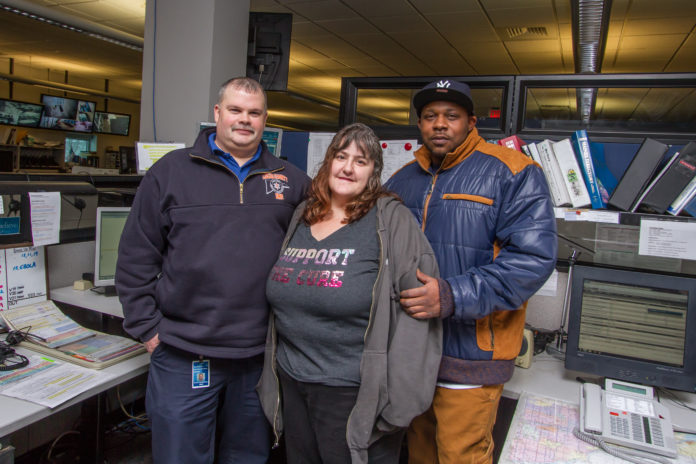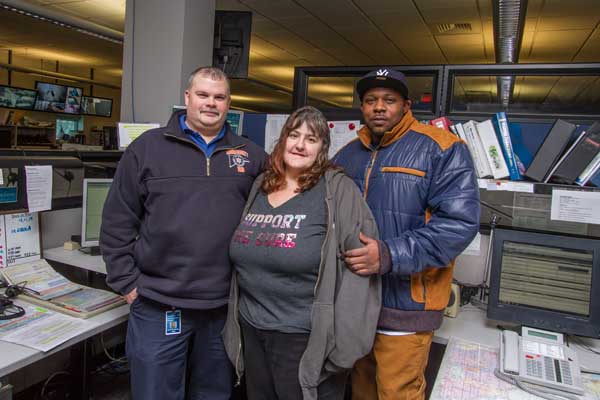
Evelyn Johnson was headed to work at Rally’s and Andra Crisp was on his way to Walmart to restock his mom’s shelves before the big storm when both noticed a vehicle off the road, still idling, against a pole in South Toledo shortly before 2 p.m. Feb. 1.
Johnson, 42, of South Toledo drove by at first, but something nagged at her and she turned around at the first opportunity, her 5-year-old goddaughter in the back seat.
“There was smoke coming out of the back, from the driver’s foot still being on the pedal,” Johnson said. “I said, ‘That’s just odd. There’s got to be something wrong.’”
Crisp, 39, also of South Toledo, said at first he thought the vehicle was just stuck in the snow so he stopped to help it dig out, pulling up right behind Johnson on Parkside Boulevard near its intersection with Hill Avenue.
As they approached the SUV, they saw an older man inside the locked vehicle, seat belt on, slumped over the steering wheel.
The man was Toledo Mayor D. Michael Collins, though neither of them knew it at the time.

Johnson called 911 at 1:49 p.m. and was transferred to Lucas County Emergency Medical Service (EMS).
“We’re banging on the windows and he’s just not responding to us at all,” she told Lead Dispatcher Brian Dempsey.
Johnson grabbed a hammer out of her trunk and Crisp used it to break open the rear driver’s side window. Johnson crawled into the backseat, turned off the car and unlocked the door.
“After he hit it, it was like something came over me,” she said. “I sprang into action. I had no gloves, but I was clearing the glass and only ended up with a teeny scratch. I jumped in the backseat and started shaking him. My adrenaline was pumping even faster.”
Toledo Mayor D. Michael Collins
Together they got Collins out of the vehicle and onto the ground. At this point, it was 1:53 p.m., four minutes since Johnson called 911.
Brain damage can start at four minutes without oxygen, said Toledo Fire & Rescue CPR instructor Nicole Knight Zmijewski. That’s why citizens willing to step in and give CPR are vital, as the average response time for paramedics is six minutes, she said.
“He’s dead,” Johnson said 40 seconds later. However, Dempsey instructed her to start CPR.
“OK, well, we’re going to try and help him,” he told her.
“OK,” Johnson responded. Neither she nor Crisp had formal CPR training, but Johnson started chest compressions around 1:54 p.m., with Dempsey talking her through the steps. After a bit, Crisp took over.
“We didn’t panic,” Johnson said. “But I would not have been able to do any of that without [Dempsey’s] help.”
Paramedics arrived by 1:55 p.m. One can be heard on the 911 audio saying, “That’s the mayor.”
“When we heard that, it was like, ‘Oh, my God,’” Johnson said. “We couldn’t believe it. We were both looking at each other like, ‘Oh, my God.’ But I would have done it for anybody.”
At that point, Johnson and Crisp went their separate ways. Crisp continued on to Walmart, only to find it closed due to the pending Level 3 snow emergency. Johnson left to drop off her goddaughter and clock into work about a half-hour late.
What happened
Paramedics radioed a diagnosis of cardiac arrest at 1:56 p.m. A life squad arrived at 2 p.m. A second EMS crew was dispatched to the scene at 2:06 p.m., arriving at 2:12 p.m.
AUDIO: Listen to the 911 call from Mayor Collins’ crash
Cardiac arrest is not the same as a heart attack. Cardiac arrest is an electrical issue, where the heart suddenly stops beating. A heart attack is a circulatory issue, caused when blood flow to the heart is cut off, usually by a blocked artery.
At 2:17 p.m., Collins, 70, was transported to University of Toledo Medical Center, where he remains in “very critical condition” in the intensive care unit as of Feb. 5.
“At this point it is too early yet to establish the timing or likelihood of his recovery,” cardiologist Dr. Christopher Cooper said in a statement from the City of Toledo on Feb. 2.
At a news conference Feb. 1, Cooper gave credit to an unnamed citizen — at the time officials only knew of Johnson — who initiated CPR at the scene.
That night, Johnson met Collins’ wife Sandy Drabik at the hospital; she brought her back to see Collins.
“Her and I just cried,” Johnson said. “But it was the best feeling. It gave me a lot of satisfaction to see him, that he was breathing, even though he’s hooked up to machines.”
Meeting
Johnson, Crisp and Dempsey met for the first time Feb. 4.
Dempsey, 38, of Northwood has been a Lucas County EMS dispatcher for 13 years and lead dispatcher since May. He’s also a firefighter with the Northwood Fire Department.
“Normally I don’t get to follow up on these kinds of things, so it’s nice to be able to follow up and actually see the people on the other end of the phone,” Dempsey said.
The call Feb. 1 came toward the end of Dempsey’s eight-hour shift, which ended at 4 p.m.
“I’m just there doing my job. I’m just doing what I’m trained to do,” he said. “These guys are the ones who stopped. They stepped up to help a stranger they just thought was broke down on the side of the road and once they found out it was much more than that, they still didn’t think twice about doing what needed to be done to help.”
Dempsey said he was also surprised to learn the man they were helping was Mayor Collins, but all three said it wouldn’t have made a difference had they known.
“It was a little bit of a shock to find that out, but then again, he’s just another person to us when we’re trying to treat him,” Dempsey said. “Whether it’s the mayor or your average Joe off the street, it doesn’t matter. We’re going to treat you the same and get you the same amount of help.”
Crisp said he feels good about the part he played in trying to help.
“Maybe God sent me that way for a reason. Maybe I’m an angel in disguise,” Crisp said.
“It felt good to help somebody,” he added. “I don’t consider myself a hero. Everybody needs help before they leave this world. If I was in the same position, I would hope somebody would do the same for me.”
Johnson agreed.
“I’m proud of what I did, but I don’t feel like a hero. I just feel like it was the right thing to do,” she said. “I’m going to help people. That’s just me. That’s how my mom raised me, to help someone in need, and to the day I pass away I will help people in need. My theory is I would want the next person to help my family.”
Johnson said she’s grateful Crisp stopped, too.
“As a team, me and him worked great,” Johnson said. “We worked together like we’d worked together forever. If it was by myself it would have been a lot harder to do.”
Both said they’d do it all over again.
“Everything happens for a reason. I don’t believe in coincidence,” Johnson said. “I truly believe I was put in his path to help him.”
What’s next
Toledo City Council President Paula Hicks-Hudson was sworn in as acting mayor on Feb. 1. Council member and former Toledo mayor Jack Ford is serving as Council president in her place.
Schoolchildren have been making cards and banners for Collins. Churches have held prayer vigils. The owner of Toledo Flags arranged for a Get Well flag to be sewn and signed.
On Feb. 3, Councilwoman Lindsay Webb led a prayer at the start of the first City Council meeting since the accident.
“We know that miracles are possible. They are possible,” Webb said.
If Collins were to die or be unable to fulfill his duties as mayor, Hicks-Hudson would become mayor until a general election is held in November.
Hicks-Hudson, a lawyer who has served on City Council since 2011 and as its president since 2013, said she doesn’t plan any major changes, at least in the short term.
The major projects Collins was working on include talks with Fiat Chrysler over the future of the Jeep Wrangler in Toledo, ProMedica’s move Downtown and the search for an end user for the former Southwyck site, said Matt Sapara, development director for the city.
“There’s a lot going on and we just want to keep heading in that positive direction,” Sapara said. “My marching orders are clear: Keep going in the direction we’re going.
“I have confidence in [Hicks-Hudson]. I know she has the best interests of the community at heart. That is very obvious and that’s something she shares with Mayor Collins.”






















